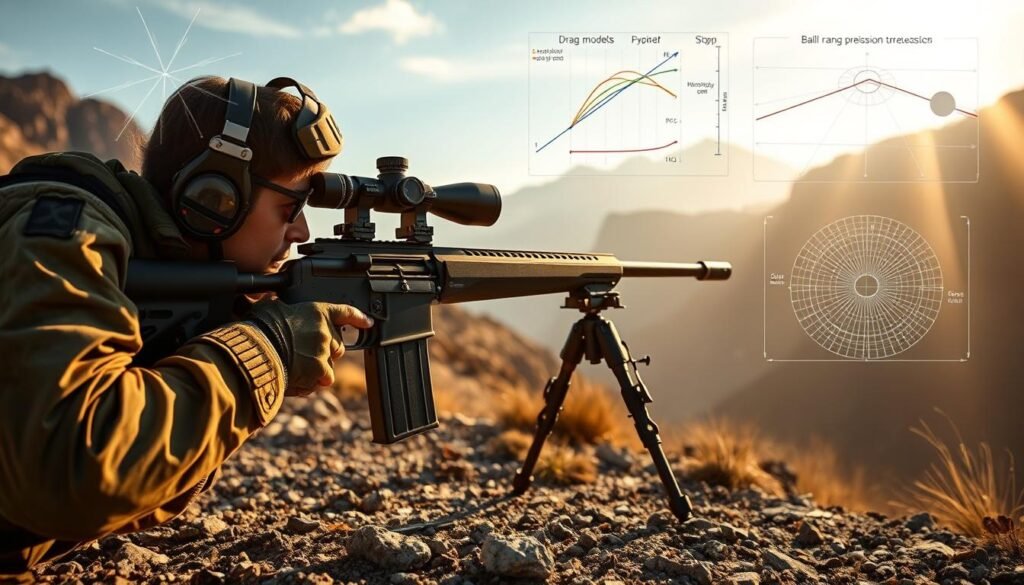Did you know a single 356-page field guide can change how shooters view long range shooting? Bryan Litz’s Volume II from Applied Ballistics packs live-fire data that cuts through noise.
This roundup focuses on tested solutions, not hype. It explains why a hardcover book and lab-backed product tests matter for rifle precision at the range.
We condense research on dispersion, handloading, rangefinder performance, rimfire ammo, drag models, and barrel tech. The goal is clear: answer the questions shooters ask before buying.
Contributors like Litz, Nick Vitalbo, and Cal Zant lend credibility. Their work helps translate ballistics science into practical tips you can use on the firing line.
Key Takeaways
- Volume II is a 356-page hardcover that delivers lab-backed ballistics guidance.
- Applied Ballistics and Bryan Litz focus on real tests, not opinions.
- This guide covers dispersion, handloading, rangefinders, rimfire, drag, and barrel tech.
- Results are aimed at rifle shooters seeking better precision at the range.
- Readers can compare price, availability, and key findings quickly.
modern advancements in long range shooting: what’s shaping the future right now
Small, testable changes—like refined handloads or different barrel profiles—are shifting what top shooters expect from long-range results.
Why this matters: Competitive margins in range shooting are razor-thin. Data-driven gains in precision often decide matches and outcomes for hunters and competitors.
The Modern Advancements series documents Applied Ballistics lab R&D using the scientific method and a mythbuster approach. Volume II ties live-fire testing to real-world performance.
Why precision depends on the method
Controlled tests remove guesswork. Repeatable protocols, transparent data, and clear variables let shooters trust the results across conditions.
“Good testing shows what actually moves the needle — not what marketing says.”
| Test Area | What Was Measured | Practical Impact | Typical Result |
|---|---|---|---|
| Bullet dispersion | Group convergence at distance | Cleaner dope and hold corrections | Smaller groups at 600–1000 yd |
| Handloading variables | Neck tension, powder fill | Repeatable velocities and tighter SD | Reduced vertical stringing |
| Rangefinder tests | Reflectivity, lighting | Reliable target returns in poor light | Fewer missed calls |
| Drag models | Real-world drop vs. prediction | Better ballistic solutions at long range | Improved hit probability |
For shooters seeking clear, test-backed information, this content cuts through noise. It answers the practical questions that matter on the line.
Product roundup: the Modern Advancements series by Bryan Litz (Applied Ballistics)
This section reviews Volume II — a 356-page resource that links experiments to real range outcomes.
Volume II overview: The book presents new research from Applied Ballistics and uses live fire testing to answer practical long range shooting questions. It is written in plain language so readers can apply results quickly.
Contributors who raise the bar: Bryan Litz brings deep ballistics experience. Nick Vitalbo tested 22 laser rangefinders. Cal Zant compared carbon fiber-wrapped and steel barrels under real conditions.
Price, availability, and where to buy
Volume II is a 356-page hardcover priced at $44.95. Applied Ballistics LLC ships domestically and offers FREE US shipping on select titles. International orders are available.
Why this product series matters
The series is non-biased and methodical. It ties controlled testing to real shooter use-cases so buyers get useful information and clear details before they purchase.
- Practical reviews and testing results
- Layman-friendly explanations
- Direct buying details: price, shipping, and availability
| Feature | What was tested | Practical takeaway | Where to buy |
|---|---|---|---|
| Rangefinders | 22 models, light/reflectivity | Choose based on lighting and target size | Applied Ballistics LLC |
| Barrel types | Carbon-wrapped vs. steel | Consider POI shift and group size | Applied Ballistics LLC |
| Ballistics data | Drag models, BC library | Improved dope and predictions at long range | Applied Ballistics LLC |
Key insights you get with these products: from dispersion to drag models
Volume II translates lab numbers into clear guidance shooters can use at the range. It ties controlled testing to practical decisions about rifle setup, load workup, and match prep.

Bullet dispersion and group convergence
Does a tight 5-shot 100-yard group predict 1000-yard precision? Part 1 measures that directly. Tests show how short-range groups correlate with long-range group convergence for different rifles.
Advanced hand-loading investigations
Part 2 uses extensive live fire testing to check powder measurement, neck tension, primer choice, fill ratio, and flash hole deburring. Results focus on ES/SD changes and on-target precision.
Pointing, trimming, and BC gains
Applied Ballistics tested 39 bullets (.224–.338) in factory, pointed, trimmed, and pointed+trimmed states. The study quantifies average BC gains and uniformity improvements for real shooting decisions.
Measured BC library and drag models
The appendix lists measured G1/G7 values for 533 bullets so shooters can validate solver inputs. Chapter 10 explains aerodynamic drag models, how they are measured, and which models best match real-world drop.
- Practical takeaway: testing and results steer choices that yield consistent velocities and more reliable trajectories.
- Use the information to answer important questions before spending time on pointing or trimming.
- Apply one change at a time on your rifle and confirm the same result at the range.
“Good testing shows what actually moves the needle — not what marketing says.”
Rangefinders, barrels, and rimfire: applied testing that guides buying decisions
Applied Ballistics’ lab work links rangefinder returns, barrel behavior, and rimfire data to practical buying choices.
Laser rangefinder performance
Nick Vitalbo tested 22 rangefinders and showed that lighting, target size, and reflectivity change performance. Low light or small, low-reflectivity targets can shorten reliable ranging distances.
Actionable point: pick a rangefinder validated under the lighting and surface conditions you expect, not just peak spec-sheet ranges.
Carbon fiber-wrapped vs. steel barrels
Cal Zant compared several carbon-wrapped and steel barrels. Results show wrapped barrels often save weight but can shift point of impact (POI) with temperature.
Practical advice: choose wrapped designs when weight matters, and choose steel when thermal stability and repeatable group sizes are highest priority.
Rimfire ammunition analysis
Chapter 9 analyzed 95 .22 ammo types across five barrels of varying lengths and twist rates. BC, muzzle velocity (MV), and consistency changed with barrel differences.
That means training and match ammo should be chosen after testing your rifle with candidate lots.
“Measured outcomes beat marketing claims when long range performance matters.”
| Test area | Key finding | Buyer takeaway |
|---|---|---|
| Rangefinders (22 units) | Performance varies with light, size, reflectivity | Validate under expected field conditions |
| Barrel types (carbon vs steel) | Weight vs POI stability and group repeatability | Prioritize weight or thermal stability by use-case |
| .22 rimfire (95 ammo, 5 barrels) | BC, MV, consistency shift with length/twist | Chronograph and test lots in your rifle before competing |
Simple test-at-home: validate a rangefinder at dawn and dusk on multiple target materials. Track POI across local temperature changes. Chronograph rimfire lots to compare MV and SD.
How to choose the right product for your needs
Start by listing the exact questions you want the book to answer at the range. Match those questions to chapters on dispersion, handloading, rangefinders, barrels, rimfire, and drag. This makes the purchase targeted and practical.
Who will benefit most
ELR competitors and F‑Class shooters will gain from deep dispersion data, solver inputs, and component guidance that tighten vertical at distance.
Data‑driven long range shooters and range shooters who build workflows can use the handloading and measurement chapters to cut ES/SD and skip low‑value steps.
Format, shipping, and support
The Volume II hardcover is 356 pages and priced at $44.95. Applied Ballistics LLC ships domestically and offers FREE US shipping on select titles, with international options available.
- Treat the book as a lab manual: follow its method to structure your own tests and record outcomes.
- Buy from the publisher when possible to simplify returns or to report issue product and contact the seller for support.
- Use double tap read and tap read brief techniques: skim first, then do a focused pass; the hardcover keeps full content visible for deep study.
- When checking reviews, favor those that critique test design, variables, and conclusions rather than just opinion.
“Use the book’s experiments as your template: test, record, compare, and confirm.”
Conclusion
Conclusion
Volume II turns lab data into steps any precision rifle shooter can use to improve performance. Applied Ballistics and Bryan Litz pack live‑fire testing, clear methods, and practical chapters into a single book that answers important questions for long range shooting.
Treat the hardcover as both reference and field companion. Skim with a tap read brief, then double down with a double tap read on chapters that match your goals: dispersion, handloading, rangefinders, barrels, rimfire, and drag.
Log your own results as you test. Buy from a reputable seller to simplify returns or to report issue product if needed. With transparent testing and repeatable methods, this title gives shooters a reliable path from question to verified improvement.
FAQ
What is “Modern Advancements: Shaping the Future” about?
It’s a research-driven series from Applied Ballistics that examines long-range shooting topics using live-fire testing and the scientific method. The books translate technical ballistics, drag models, and experimental results into practical guidance for precision rifle shooters.
Why do these developments matter for precision rifle shooters?
Today’s equipment and techniques can change point of impact, group size, and effective range. Understanding real-world data on dispersion, ballistic coefficients, and barrel behavior helps shooters make evidence-based choices that improve consistency and performance.
How does Applied Ballistics separate science from marketing hype?
The team uses controlled live-fire experiments, repeated trials, and transparent reporting. They publish methods, sample sizes, and raw findings so readers can judge validity rather than rely on vendor claims or anecdote.
What is included in the Modern Advancements series by Bryan Litz?
Volume II focuses on myth-busting research, extensive live-fire testing, and real-world results. It covers hand-loading practices, bullet pointing and trimming, measured BCs, and applied drag models. Bryan Litz leads the work with contributions from Nick Vitalbo and Cal Zant.
Who contributed to Volume II?
Key contributors include Bryan Litz, Nick Vitalbo, and Cal Zant, each bringing field testing, data analysis, and applied ballistics expertise to raise the overall rigor of the studies.
How much does Volume II cost and where can I buy it?
Volume II is listed at .95. It’s available from Applied Ballistics LLC, which offers domestic shipping and occasionally free US shipping on select titles. Check the Applied Ballistics website for current inventory and shipping options.
What practical insights will I get from these products?
Readers gain actionable knowledge on bullet dispersion and group convergence, BC measurement techniques (G1/G7), aerodynamic drag models, and detailed hand-loading procedures such as flash hole deburring, neck tension control, and powder measurement.
How does the series address bullet pointing and trimming?
The team tested pointing and trimming across calibers from .224 to .338 to quantify any ballistic coefficient gains and uniformity improvements, providing data-driven recommendations rather than assumptions.
What ballistic coefficient data does the series include?
The research provides a measured BC library covering hundreds of bullets—over 500 entries—using both G1 and G7 references to support model selection for different projectile shapes.
Do the books explain aerodynamic drag models in simple terms?
Yes. Complex drag model concepts are translated into practical explanations so shooters can predict real-world drop and wind drift with greater accuracy using applied ballistics tools.
Are there tests on rangefinders and optics performance?
The series includes applied testing on laser rangefinder performance, showing how lighting, target size, and reflectivity affect measurement reliability and how that should influence buying decisions.
How are barrels compared in the research?
Tests compare carbon fiber-wrapped and traditional steel barrels for point-of-impact shift, group size, and thermal behavior, giving shooters data to weigh weight savings against potential accuracy trade-offs.
Is rimfire ammunition covered?
Yes. The research analyzes rimfire ammo for ballistic coefficient, muzzle velocity consistency, and shot-to-shot variation across different barrels to guide selection for precision rimfire work.
Who benefits most from this series?
ELR competitors, F-Class shooters, and data-driven long-range marksmen benefit the most. Any shooter who values empirical testing and wants to improve precision through measured practices will find actionable content.
What formats and support options are available?
The series is available in hardcover with domestic and international shipping options. Applied Ballistics provides customer support and ordering details on their website, including shipping rates and availability.



